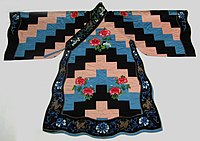Shuitianyi
| Shuitianyi | |||||||
|---|---|---|---|---|---|---|---|
 A shuitianyi which was used as a theatrical robe for a female Daoist priest (front view), 18th century. | |||||||
 A shuitianyi which was used as a theatrical robe for a female Daoist priest (back view), 18th century. | |||||||
| Chinese | 水田衣 | ||||||
| Literal meaning | "Paddy field garment" or "rice-paddy robe" | ||||||
| |||||||
Shuitianyi (Chinese: 水田衣), also known as “paddy field garment”, "Shuitian clothing", or "rice-paddy robe",[1] is a non-religious patchwork gown which was made and worn by women in China during the Ming dynasty and Qing dynasty; it was made by using many pieces of fabric sewn together (similar to Chinese patchwork); the clothing reflected the era’s tendency towards fashion novelty during the Ming dynasty.[2][3][4][5]
Origins and Development[]
The shuitianyi is a popular, but rare fashion phenomenon, which appeared in the middle and the late Ming dynasty and remained popular in the Qing dynasty.[5][6] The shuitianyi may have originally originated from poor people, who would use whatever leftover clothing they would have at hand for saving purposes, and was initially only popular among poor women.[5] Its origins may have been inspired by Buddhist robes,[4] the Kasaya or Baina, which was made when monks would make clothes out of a variety of useless clothes.[5] It was later adopted by aristocratic women during Ming dynasty who found it beautiful, and they began to cut cloth (even from entire brocade) voluntarily into a design shape and sew it into an aristocratic form of the shuitianyi.[5] While the shuitianyi was a popular form of fashion for women in the Ming dynasty, men during this era would also wear baina clothing.[5]
Other versions of the Shuitianyi[]

The version of the shuitianyi worn by children is called baijia clothing.[5]
See also[]
References[]
- ^ "Theatrical robe for a female Daoist priest 18th century". www.metmuseum.org. Retrieved 2021-12-23.
- ^ Hanson, Marin F (2014). ""One Hundred Good Wishes Quilts": Expressions of Cross-Cultural Communication". Uncoverings. 35: 69–89 – via Art Index (H.W. Wilson).
- ^ "Costume in the Ming Dynasty - - China Style". www.chinastyle.cn. Retrieved 2021-02-06.
- ^ a b Finnane, Antonia (2008). Changing clothes in China : fashion, history, nation. New York: Columbia University Press. pp. 48–49. ISBN 978-0-231-14350-9. OCLC 84903948.
- ^ a b c d e f g Yin, Zhihong (2019). "Study on the Evolution and Development of Baina Clothing to Shuitian Clothing in the Ming and Qing Dynasties". Advances in Social Science, Education and Humanities Research. Atlantis Press. 368: 315–318. doi:10.2991/icassee-19.2019.65. ISBN 978-94-6252-837-6.
- ^ Gao, Yingpei (2018). "Application of Patchwork Art Form in Traditional Costumes: A Case Study of Baijia Clothes". Journal of Landscape Research. 10: 98–100 – via ProQuest.
- Chinese traditional clothing